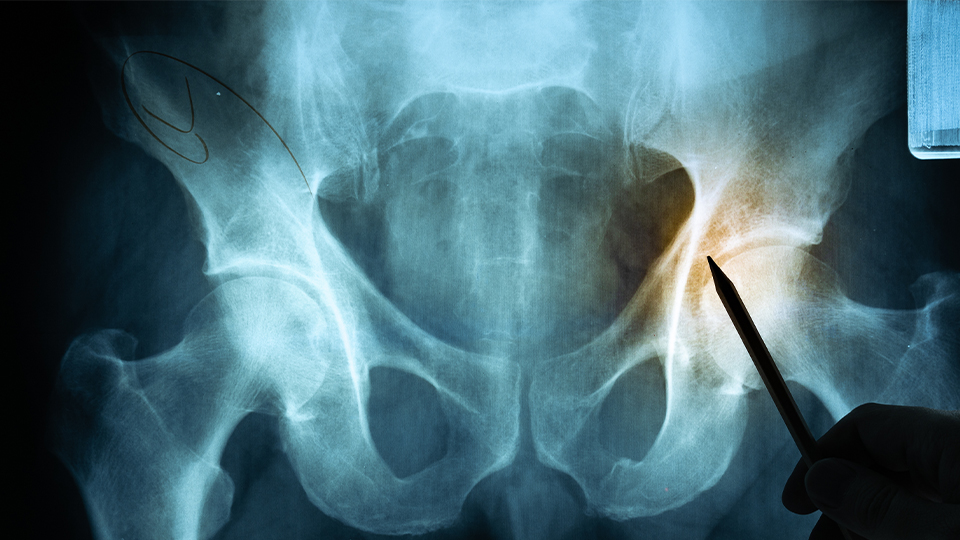Predicting the risk the osteoporotic hip fracture in men using blood markers
Published: 31 Aug 2022

Copyright: alicephoto
Bone health requires a balanced activity of various bone cell types including bone-forming osteoblasts and bone-resorbing osteoclasts.
Osteoporosis occurs when osteoclasts – the cells that are responsible for bone breakdown – proliferate faster than the bone can form adequately, resulting in higher fragility of bones and higher risk of fractures.
Previous work by Associate Professor Christoph Winkler and his team from the Department of Biological Sciences (DBS), National University of Singapore (NUS), has identified that CXCL9, produced by osteoblasts, promotes differentiation of osteoclast progenitors into osteoclasts, with resultant resorption.
In a new research published in the Journal of Bone and Mineral Research, a collaboration between the team, led by Professor Koh Woon Puay from the Healthy Longevity Translational Research Programme at the Yong Loo Lin School of Medicine, NUS (NUS Medicine) and the team led by Assoc Prof Winkler sought to assess the association between CXCL9 and the risk of osteoporotic hip fracture in humans.
The longitudinal study was conducted among a subgroup of Chinese men and women who are participants of the population-based Singapore Chinese Health Study.
The study included 55 men and 119 women who had experienced a hip fracture an average of 6.3 years after their blood was collected. The participants were matched individually to controls who did not develop hip fractures in the cohort.
Two chemokines, CXCL9 and CXCL10, have been implicated in different osteoimmuno-modulating pathways, and share a common receptor, CXCR3, in triggering cell migration of osteoclasts. Hence, the team assessed whether levels of serum chemokines, CXCL9 and CXCL10, were elevated in human serum samples of older adults who had incident hip fractures, and if these two chemokines were associated with hip fracture risk.

Immature osteoclast precursors (blue to magenta depending on maturation state) aggregate at osteoporotic bone and mature into bone resorbing osteoclasts (green). Osteoclast recruitment and differentiation is triggered by CXCL9 that is produced by osteoblasts. Photo credit: Quang Tien Phan
Investigators observed higher blood levels of the chemokine CXCL9 in the pre-fracture blood samples of men with subsequent hip fractures compared with their non-fracture controls, and their analysis showed that the serum CXCL9 improved the prediction of osetoporotic hip fracture in men.
In contrast, there was no such difference in CXCL9 serum levels between the hip fracture cases and non-fracture controls among the women. Conversely, the association between CXCL10 and hip fracture risk was no statistically significant in either gender.
Overall, the data collected from this study suggested that CXCL9 could be used as a predictor of hip fracture risk in older men, and opened the possibility that early interventions targeting CXCL9 or CXCL9-CXCR3 signalling, could be beneficial in preventing hip fractures in older men. The null finding in CXCL10 for both men and women suggests that these two chemokines may have different effects on human bone physiology. Nevertheless, these results need to be confirmed in future studies with larger sample sizes.
“The unexpected difference in the results between men and women in our study may be explained by how changes in sex hormone levels during aging could influence the level and effects of CXCL9 differently in older men and women,” explained Prof Koh.
“Our findings open the exciting possibility that early interventions targeting CXCL9 or CXCL9-CXCR3 signalling could be beneficial in preventing hip fractures in older men,” added Assoc Prof Winkler.
This research was selected to be featured in Wiley’s Research Headlines. It is a mailing that includes summaries of the most newsworthy research sourced from more than 1,600 journals worldwide published by Wiley, and reaching more than 6,000 journalists and subject-targeted media outlets.


